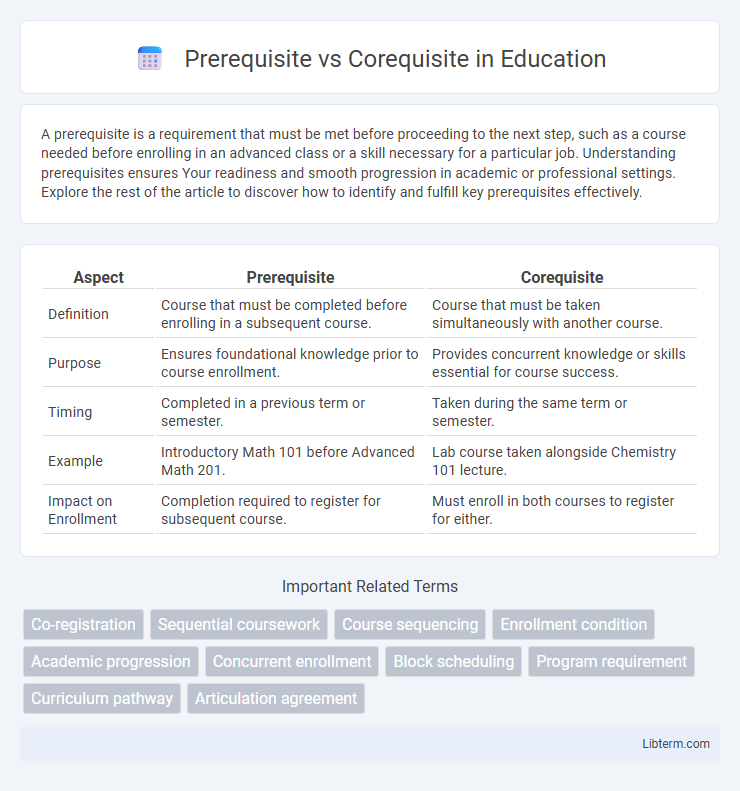A prerequisite is a requirement that must be met before proceeding to the next step, such as a course needed before enrolling in an advanced class or a skill necessary for a particular job. Understanding prerequisites ensures Your readiness and smooth progression in academic or professional settings. Explore the rest of the article to discover how to identify and fulfill key prerequisites effectively.
Table of Comparison
| Aspect | Prerequisite | Corequisite |
|---|---|---|
| Definition | Course that must be completed before enrolling in a subsequent course. | Course that must be taken simultaneously with another course. |
| Purpose | Ensures foundational knowledge prior to course enrollment. | Provides concurrent knowledge or skills essential for course success. |
| Timing | Completed in a previous term or semester. | Taken during the same term or semester. |
| Example | Introductory Math 101 before Advanced Math 201. | Lab course taken alongside Chemistry 101 lecture. |
| Impact on Enrollment | Completion required to register for subsequent course. | Must enroll in both courses to register for either. |
Understanding Prerequisites: Definition and Purpose
Prerequisites are courses or requirements that students must complete before enrolling in a more advanced class, ensuring foundational knowledge necessary for success. Their purpose is to build critical skills and concepts sequentially, preventing gaps in understanding that could hinder academic progress. Establishing clear prerequisites helps maintain curriculum coherence and prepares students for complex subject matter.
What Are Corequisites? Explained Simply
Corequisites are courses that students must take simultaneously with another course to ensure they acquire complementary knowledge and skills needed for success. Unlike prerequisites, which are completed before advancing to the next class, corequisites provide immediate support, often pairing theoretical material with practical application. Many universities design corequisite courses to enhance understanding, improve retention, and accelerate academic progress in subjects like mathematics, science, and language studies.
Key Differences Between Prerequisites and Corequisites
Prerequisites are courses or requirements that must be completed before enrolling in a subsequent class, ensuring foundational knowledge is acquired, while corequisites are courses that must be taken simultaneously with another class to complement learning. The key difference lies in timing: prerequisites establish sequential learning, whereas corequisites emphasize concurrent instruction. Understanding these distinctions enhances academic planning by aligning course progression with educational goals and institutional policies.
Why Do Schools Require Prerequisites?
Schools require prerequisites to ensure students possess the foundational knowledge and skills necessary for success in more advanced courses. Prerequisites help maintain academic standards by preparing students to handle course content and promote efficient progression through degree programs. This system reduces the risk of course failure and supports comprehensive understanding in specialized subjects.
The Role of Corequisites in Course Planning
Corequisites play a crucial role in course planning by allowing students to enroll in two related courses simultaneously, ensuring they acquire necessary foundational knowledge while advancing in more complex subjects. Unlike prerequisites, which require prior completion before enrollment, corequisites facilitate integrated learning experiences and enhance understanding through concurrent coursework. This approach supports timely progression and academic success, particularly in fields requiring practical application alongside theoretical study.
How to Identify If a Course Has Prerequisites or Corequisites
To identify if a course has prerequisites or corequisites, check the course catalog or academic program guide where these requirements are clearly listed. Prerequisites are courses that must be completed before enrolling, while corequisites are courses that must be taken simultaneously or alongside the main course. University websites and registration systems often display these conditions under the course description or enrollment requirements.
Impact of Prerequisites vs Corequisites on Academic Progress
Prerequisites establish foundational knowledge required before enrolling in advanced courses, often ensuring students are adequately prepared, which can streamline academic progress by reducing the risk of course failure. Corequisites, mandated to be taken simultaneously with related courses, promote integrated learning and immediate application of concepts, potentially accelerating comprehension but posing scheduling challenges. The impact on academic progress differs as prerequisites may delay advancement until requirements are met, while corequisites demand balanced workload management to avoid overextension during the same term.
Common Examples of Prerequisite and Corequisite Courses
Prerequisite courses are classes students must complete before enrolling in a more advanced course, such as Calculus I before taking Calculus II or General Chemistry I before Organic Chemistry. Corequisite courses require simultaneous enrollment, often seen with lecture and lab pairings like Anatomy lecture and Anatomy lab or Physics I with its corresponding lab. These structures ensure foundational knowledge or concurrent skill application critical for academic success.
Strategies for Fulfilling Prerequisite and Corequisite Requirements
Fulfilling prerequisite requirements involves completing designated courses or demonstrating proficiency before enrolling in advanced classes, often through targeted study plans and scheduling to ensure timely progression. Corequisite strategies include concurrent enrollment in required courses, enabling simultaneous acquisition of foundational and advanced knowledge while maintaining academic standards. Utilizing academic advising and institutional resources optimizes course sequencing, reduces scheduling conflicts, and enhances overall success in meeting prerequisite and corequisite obligations.
Frequently Asked Questions About Prerequisites and Corequisites
Frequently asked questions about prerequisites and corequisites often focus on their definitions, differences, and enrollment impact. Prerequisites are courses or requirements that must be completed before enrolling in a specific class, ensuring students have necessary foundational knowledge. Corequisites differ by requiring simultaneous enrollment in another course, often used to supplement learning and provide concurrent support.
Prerequisite Infographic

 libterm.com
libterm.com